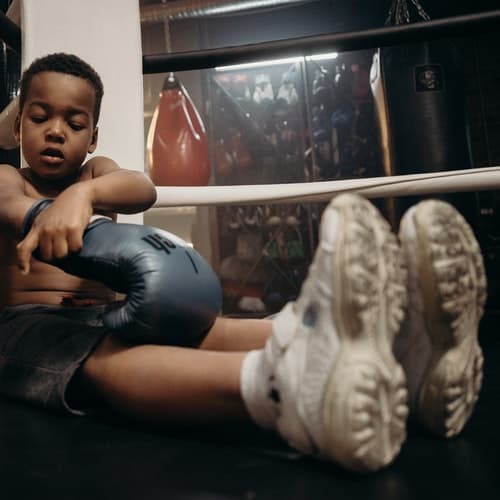In a time of crisis, all parents need to understand how to support their child’s resilience. Across Nigeria, the recent #EndSars protests, the aftermath of the shootings and nationwide looting has caused a lot of stress and caused people to be sad, anxious and worried about the future.

We understand that children are more vulnerable than adults. Globally traumatic events like 9/11 have taught experts how to guide parents to be prepared to respond to crises in ways that help their children be resilient.
Children depend on adults for safety and security, and many adults do not feel safe or secure themselves. Children as young as infants and toddlers are keen observers of people and environments, and they notice and react to stress in their parents and other caregivers, peers, and community members.
With consistent support and age-appropriate responses, children can be incredibly resilient. However, children who do not receive appropriate support and nurturance during this time could be at risk of developing significant mental health problems.
Even as we continue to juggle multiple competing responsibilities and endure our own stresses and anxieties, parents need to be especially conscious as we are shaping how our children will deal with future adversities.
Sources of Dealing with Crisis
It may be useful to consider the following three sources from which children draw resilience.
The first is, I HAVE Sources: These refer to resilience-promoting external supports and resources.
Secondly is, I AM Sources: These refer to internal resilience-promoting qualities, such as feelings, attitudes, and beliefs.
and lastly is, I CAN Sources: These refer to resilience-promoting social and interpersonal skills.
These are based on data from the International Resilience Project, which is a large-scale study of child resilience with participants drawn from 11 countries by Yates and Masten.

3 Steps to Develop Resilience
1. Reassurance
How you respond to crisis greatly influences your children’s response, so try telling your child how you feel in an age-appropriate way. Modelling a healthy expression of emotion will create a safe space for your children to do the same.
Remember that your child(ren) need to hear hopeful messages. While you may not be able to guarantee that things will be okay, expressing optimism will provide them with psychological safety.
2. Routine
Maintain or create a daily routine and try to stick to it as much as possible. Start by deciding in advance what activities will be included. Make the schedule visible to them so they feel included. It does not have to be rigid but rather offer a guideline and helps everyone know what to expect.
3. Regulation
Young children experience many of the same emotions as adults, but they often lack the self-control and language skills to express their feelings. Instead, children often act out these emotions in very physical ways, such as screaming, yelling, yanking, stomping and throwing toys. Stress can become toxic to children if no supportive relationship is available.
Your Self-care is important in taking care of your child
Your children will notice if you feel anxious, depressed, hopeless, and/or chronically fatigued. It is common to experience these feelings, especially during such an uncertain time. Remember that in order to take good care of your children and be a positive role model, you must take care of yourself. You can read more about how children need parents who are mentally healthy.
Types of Stress
Children can experience a number of stressors throughout their childhood. It’s important to note that not all stress is bad stress. There are generally three levels of stress. These are known as positive stress, tolerable stress and toxic stress.
Positive stress refers to common, routine life events that may cause a temporary increase in our stress level from which we quickly recover. Some examples in children include learning to ride a bicycle, getting immunizations at the doctor’s office or the first day of school. Each of these experiences is temporary and do not traumatize the child.
“It is easier to build strong children than to repair broken men.” Frederick Douglass
If there’s one thing we can always be sure of, it’s that adversity is inevitable. Moreover, while every generation has had its own unique challenges; it also can be argued that the demands, anxieties, and pressures faced by young people today present an exceptional challenge to healthy development.
Dangers of Toxic Stress
The result of the extended stress response is that a child’s nervous system, immune system and even DNA are changed. Toxic stress causes the fear centres of the brain (limbic system, amygdala) to significantly increase in size. In such cases, the child can develop symptoms very similar to post-traumatic stress disorder (PTSD).
Toxic stress decreases the size and impairs the functioning of the regions of the brain responsible for learning, memory and executive functioning (prefrontal cortex, hippocampus).
Learning how to cope with adversity is an important part of healthy child development. When we are threatened, our bodies prepare us to respond by increasing our heart rate, blood pressure, and stress hormones, such as cortisol.
When a young child’s stress response systems are activated within an environment of supportive relationships with adults, these physiological effects are buffered and brought back down to baseline. The result is the development of healthy stress response systems. However, if the stress response is extreme and long-lasting, and good support is unavailable, the result can be damaged, weakened systems and brain architecture, with lifelong repercussions.
“There can be no keener revelation of a society’s soul than the way in which it treats its children.” Nelson Mandela, former president of South Africa.
Controlling Stress
When bad things happen, the only thing we can control is our response. Individuals can either crumble or according to Dr Gregg Steinberg in his Ted Talk, they can ’ fall up’. They do this by using their “painful experience as a chisel to free their authentic self, to become the person they’re meant to be.
Children will model after what they see – perhaps regardless of what they hear. Thus, parents are more likely to raise resilient children if their children see them as strong and competent role models who do not crumble under pressure.
[Tweet “parents are more likely to raise resilient children if their children see them as strong and competent role models who do not crumble under pressure.”]
There are several factors that contribute to protecting children and helping them to adapt and cope with tough times. The family, community and the individual child all have a part to play.
What Parents Can do in a time of crisis
Listen to your Children
Parents should listen to their children and especially during a time of crisis. Phillip Kendall’s Coping Cat method encourages the use of empathy and encouragement.
You start by letting your child know that you hear them and acknowledge how they feel. Thereafter you can shift to encouragement. Let your child know that you will work through this together.
Where your child is reacting in a fit of emotion, first try to calm them out with a heartfelt hug. After the hugs, ask your child what they understand about what has happened. You can ask them about what questions or concerns they might have. You want to listen for any potential misunderstandings.
It is common for children to have fears based on limited information or from not understanding what they have heard or seen. You must first listen to your child’s concerns so you can frame your discussions. Be sure to present the situation appropriately and spare them frightening or unnecessary details. When they are finished talking, then you can help them to make sense of their emotions. Always end on a positive note.
Help them to express how they feel
Just asking children how they feel may not be enough to get them to voice their feelings. Sometimes simply sitting with them helps. You can also be there while they draw a picture or play with their toys. This can help them find a way to communicate what they are feeling.
Young children
- Young children may need your help to find the words to express what they are feeling. Offer them words to choose from by telling them it’s normal to feel sad, upset, or confused. Be a good role model by sharing how you are feeling and explaining what you are doing to help yourself feel better. Encourage them to express feelings through play, drawing, storytelling, or other creative activities.
Older children & adolescents
- Older children and adolescents might find it easier to talk about what others think. Encourage older children to ask questions and share their feelings. Answer their questions with calm, age-appropriate responses and do not belittle their emotions.
Never force your child to talk
Some children will act as if they aren’t bothered at all. They don’t seem particularly interested in or moved by the event. If so, there’s no reason to push them to express anything at this time. Never force your children to talk, but tell them you are there to listen.
Dealing with Mixed Emotions
It is common for people to have a mixture of emotions in the face of all that has happened. At this time children are painting a picture of what it means to protest. In addition, they are trying to make sense of why there has been so much looting among other concerns.
Your child can be wondering why people are so cruel and they might be angry, scared or frustrated. Children might even wonder about God at this time. You need to be able to help them express themselves and offer the encouragement they need. Remember your children are making sense of the world. They need their parents to give them hope and a sense of calm.
If your children have any anger or confusion let your first response be to listen. Do not deny their feelings or try to talk your children out of it.
What to Say to Children
The way we communicate through our body language and tone may be more important than our exact words. In the face of a crisis, gather the family together and have regular conversations. You may want to begin the conversation with everyone present to feel more secure when you are all together. Have the right level of conversation depending on your children’s age and developmental level.
More than anything else, adults must be honest about what has happened. Sadly, this is not the kind of truth that we can protect our children from. It is essential to keep in mind that the truth doesn’t need to include every horrid detail. How much detail to share will depend on their ability to understand.
For young children
Share only simple, concrete explanations of what happened and how it affects them. If they have a gross misunderstanding of events, correct them. But if they explain the story in a simple way do not correct them or add more nuanced details. Their simple explanations may be exactly what they need to believe to feel safe. Don’t take away that sense of security they’re constructing for themselves.
For older children & adolescents
They are likely to ask for and benefit from additional information about the disaster and recovery efforts. With the internet and social media, your children already have some information and have formed some opinions already. It is important to have open and honest conversations.
Don’t worry about saying the perfect words. Nothing we can say in these circumstances will make everything better. Don’t feel obligated to give a reason for what happened. It’s OK to say you don’t know why something so terrible has happened.
Give your child a sense of safety
As we try to explain events in the midst of a crisis; the main goal is to reinforce that you and your children are safe. If it isn’t clear that you are yet safe, don’t lie. Focus instead on the steps you are taking to become safer.
The National Child Traumatic Stress Network suggests telling children how the crisis affects their family, school, and community. They may be worried about the safety of their friends or extended family. Reassure them that their friends’ parents are taking care of them, just like you are. 
Emotional Intelligence During Crisis
If your family has been a witness via the media, you will still need time to restore some emotional balance. During these periods, a few small things can help children.
Get back to old routines
As soon as reasonably possible, try to follow old routines. This is because children thrive on structure. Follow as normal a schedule as possible. You can maintain some family routines like singing songs or reading stories before bedtime. However, be aware that changes in behaviour may be a result of fears or insecurities. These can be alleviated through repeated reassurances and extra attention.
Remember that your children’s world revolves around you and your home. Any disruption to your normal family activities will be felt by your children. It is important to realise that things that may seem trivial to you are not to your children. Activities like watching television, playing on the computer, or having friends over, are important to your children. As a result, these activities will be seen as tremendous losses if they are disrupted. Therefore, be patient and help children think of alternative activities.
Find ways to help others
Finally, provide your children with opportunities to help others. Children cope better and recover sooner when they help others. This is because it creates a sense of control and helps children feel better about themselves.
Limit Exposure to the Media
Try to monitor and limit your children’s exposure to the news. As compelling as it may be news coverage is often overwhelming. The reality is that today’s 24-hour news cycle and online content replays dramatic footage all the time. This non-stop imagery and news can expose your child to gory images and increase trauma. [Read: How to Raise Children with Digital Resilience]
It is advisable to shield your children entirely or limit the time they spend viewing media related to the incident.
Even indirect disaster exposure from media (eg, newspaper, television, internet, social media) can be detrimental. It may change the way they view the world; they may begin to see it as a threatening, scary place. It is important for parents to limit media exposure in general. Also, take the time to explain in words they understand what they do see and hear. Be honest, but spare your children from unnecessary or frightening details.
While children can benefit from basic information about what happened; it can be harmful to them to see graphic images or sounds. Try to encourage realistic messages of hope and optimism.
Point out some of the positives of the trauma; such as how people help each other or how heroes risk their own lives for others.
Even in the most difficult situation, your positive outlook on the future will help your children. This will help them to see good things in the world around them and help them through challenging times.
Children are Watching
Children rely on us so heavily to figure out how to interpret events during a crisis. They learn so much from us and other adults. They listen to our words and notice the level of stress that our bodies communicate. It is important to note that when adults are speaking secretly, this raises your child’s anxiety level. So be sure to speak openly or find a private place to have more sensitive conversations.
The bottom line for parents is to remain calm and to remind children they are loved. Additionally, let them know that you are doing everything you can to keep them safe. Feeling secure and connected to parents, family members, teachers, friends, or community is the greatest protection children have. Ultimately this affects their recovery immediately after a disaster and well into the future.
Listen to the audio podcast of this blog post
You can read more here on how to raise children with digital resilience.


